Blue spruce: description, planting and care, reproduction

Blue spruce is a beautiful and noble evergreen coniferous tree. It grows both naturally and at home. Compositions of dwarf blue fir trees are popular among landscape designers, and large trees often decorate public parks and squares. What are the general characteristics of blue spruce trees? What is the difference between tree varieties? How to choose the right and how to care for the plant? You will find answers to these and some other questions in our article.
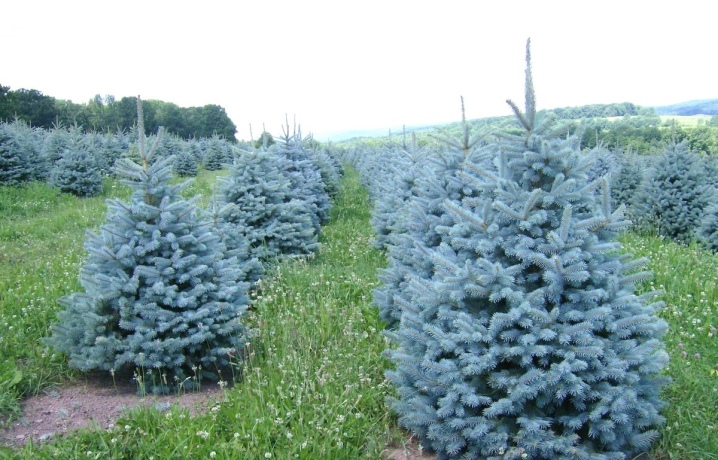
Description
Spruce (in Latin - Picea) is a popular and well-known coniferous evergreen tree. One of the varieties of spruce is blue spruce (the second name is prickly spruce). The root system of the plant is located quite close to the soil surface, but even so, the tree is quite strong and resistant to adverse weather conditions (for example, to strong winds). In nature, blue spruces mostly grow in western North America. However, today trees are common far beyond the borders of this country. Moreover, they grow not only in natural conditions, but also in backyard private territories. Many homeowners plant fir trees to decorate their property.

Spruce does not bloom. It also cannot be said that it is growing rapidly. Nevertheless, due to these characteristics, it is not becoming less popular plant and is actively used in landscape design.
The average height of a blue spruce is 30 meters. but scientists have recorded individual specimens, the height of which reaches 46 meters... Such specimens are champions. Under natural conditions, the tree can most often be found in areas close to water bodies. Despite the fact that the name of the spruce is “blue”, the color of the needles of the tree can vary within several shades, acquiring a silvery, white or green undertone. Thus, the decorative properties of the plant are manifested.

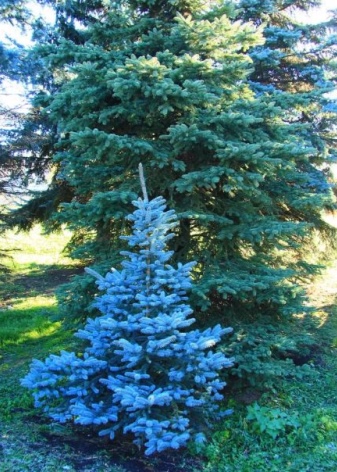
Varieties and their characteristics
Today, botanical scientists distinguish a wide variety of blue spruce species. Let's consider the most common of them, get acquainted with their distinctive characteristics and features.
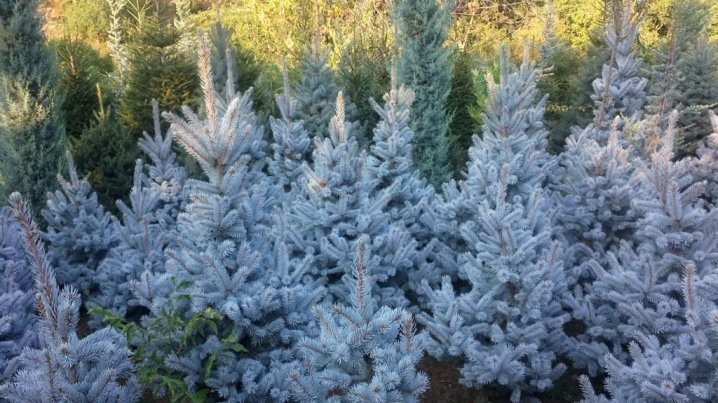
Kaibab
Kaibab is one of the most popular varieties of blue spruce. An evergreen coniferous tree has an asymmetric and columnar crown. The branches are located close to each other with high frequency. They create the density and splendor of the tree. The maximum growth rates for spruce are 2 meters in height. Moreover, the crown diameter can reach 3 meters. Each year, the tree adds 8 centimeters in height and 10 centimeters in width.
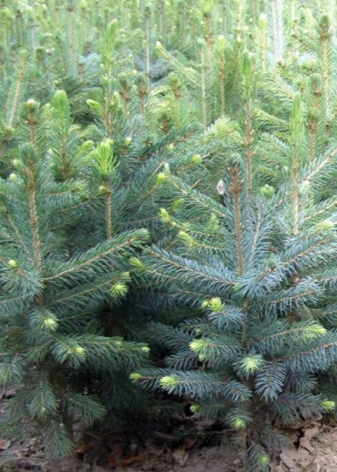

The needles have a silvery-blue color. However, over time, the color can change, acquiring dark green undertones (this is especially typical for those spruces that grow in the shade). It is quite prickly and thick to the touch. The arrangement is radial sickle-shaped. The needles 1-1.2 centimeters long are rather thin, their diameter is 1 millimeter. Representatives of the Kaibab variety are undemanding in relation to the soil in which they grow. However, in order for the tree to develop more actively, it is necessary to carry out mulching. For planting, it is better to choose light areas.
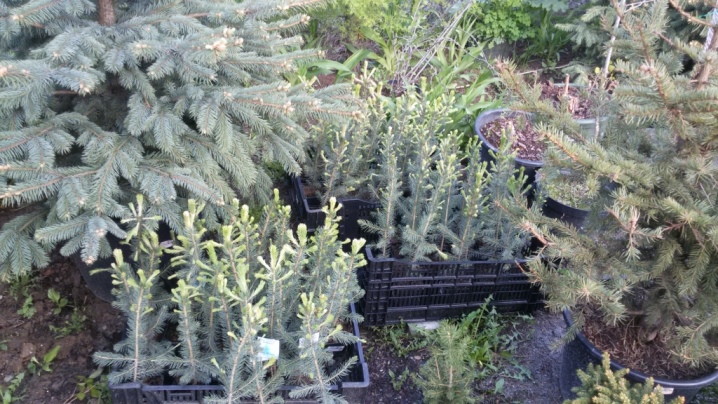
It is also important to note that Kaibab is a frost-resistant variety of blue spruce. The plant also tolerates drought well. It can grow in an urban environment. Can be planted as a single planting or in rock gardens.
The name "Kaibab" was given to this plant in honor of the national reserve. A unique feature of spruce is the ability to change the shade of its crown to a bluer one over time (annually).
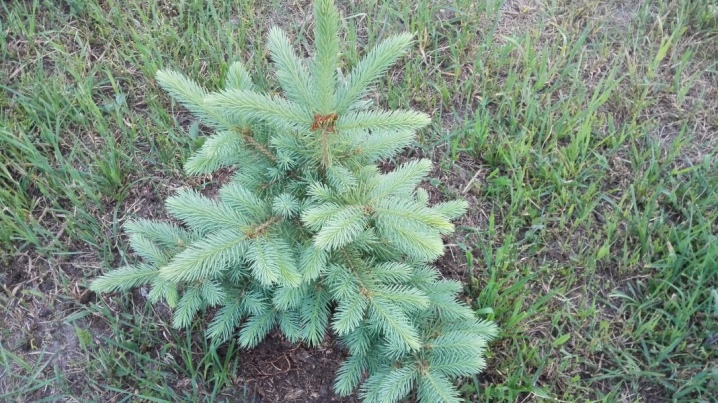
Oldenburg
The variety "Oldenburg" (or Oldenburg) is an ornamental spruce with a regular and wide crown. It is dropped rather low in relation to the surface of the earth, and the color of the needles is blue with silvery undertones. The maximum height is 15 meters. At the same time, the tree grows very slowly. So, for example, at the age of 10 years, blue laziness usually does not exceed a height of 3 meters. The trunk of the Oldenburg variety is covered with brown-gray bark, while young shoots and branches are brown-orange. The needles are short and thick and have 4 edges. The color can range from steel bluish to silvery white. It should be borne in mind that there is a wax coating on the surface of young needles.

The size of the plant cones reaches 8 centimeters. They have a cylindrical shape and a loose structure. Young buds can be yellow in color, but with age, they change their color to light brown. The root system "Oldenburg" belongs to the category of superficial. But despite this, the tree is resistant to even strong winds, respectively, it can be planted in those areas that are characterized by unfavorable weather conditions.
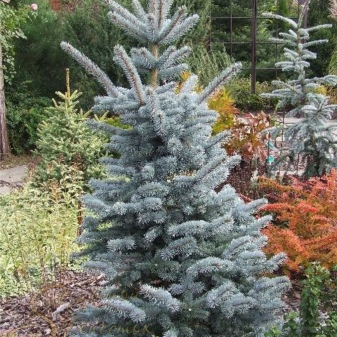
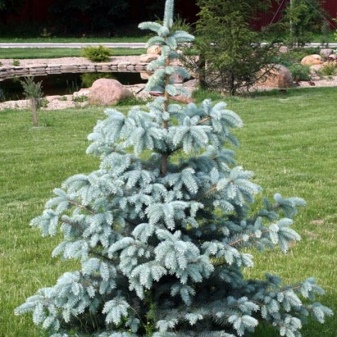
It is recommended to grow representatives of this variety on loamy and sandy loam soils. In this case, the plots themselves should be sunny. Please note that the tree will not survive in saline and overconsolidated soils.
Waldbrunn
Waldbrunn is a thorny spruce that grows slowly. The crown of the tree has a nest-like shape and is loose in itself. With age, the crown of a spruce can change its shape and acquire a conical shape. Gardeners should take into account that the growth rate of grafted plants is much higher, the shape of the crown is more correct - conical.

By its dimensions, "Waldbrunn" is a small tree. An adult spruce does not exceed 80 centimeters in height, and its diameter is 100 centimeters. The needles of the plant are gray-gray with a blue or silver tint. At the same time, young needles have a more pronounced bright and saturated color. The needles of the tree are soft to the touch and quite thick in structure. They are usually located on densely spaced shoots.
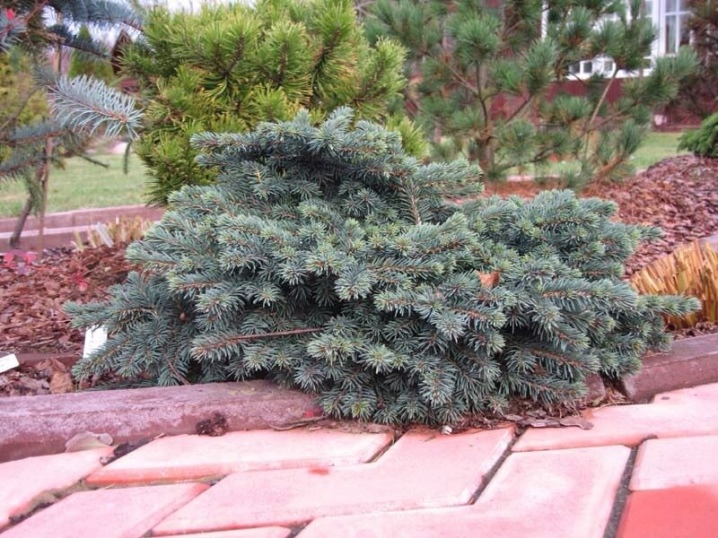
The Waldbrunn variety is characterized by a fairly high winter hardiness. At the same time, for planting, it is better to select sunny areas or at least areas in partial shade. If you want the crown of the tree to have a well-defined and shaped crown, then you should tie the tree up. The structure of the tree crown is bushy and spreading. One is homogeneous and uniform without a pronounced conductor, and the branches of "Waldbrunn" are located in a horizontal position.
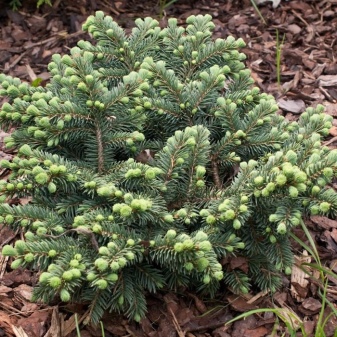
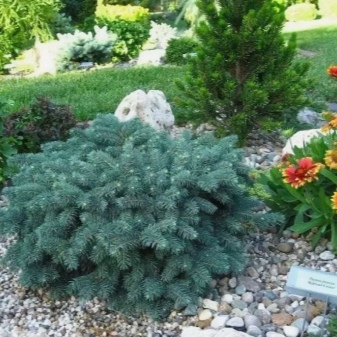
Such spruces are most often planted in rocky or heather gardens. Spruce belongs to the dwarf group, so landscape designers often use it to decorate personal plots. It looks beautiful in compositions with other small-sized conifers and deciduous plants. For planting varieties, preference should be given to moderately fertile, moist and drained soil. It is also desirable that the soil is slightly acidic. At the same time, "Waldbrunn" does not tolerate the soil with stagnant waterlogging. For the winter, the plant does not require shelter.
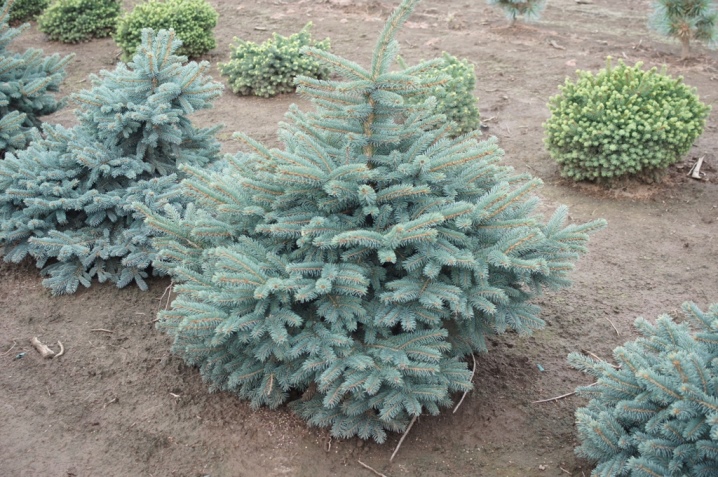
Fat Albert
"Fat Albert" is a variety of blue spruce, the distinctive feature of which is the crown.It has a regular conical shape. In height, an adult plant can reach 15 meters, while the maximum width is 3.5 meters. The tree grows quite quickly - this characteristic distinguishes this variety from other varieties that have been described above. During the year, the plant grows no more than 30 centimeters in length and adds about 15 centimeters in diameter. The plant reaches ten meters in height at the age of 30 years.

The needles of the "Fat Albert" variety are colored in a silvery-blue hue, their length can reach 3 centimeters. Spruce branches grow at an angle of 90 degrees. They are tough enough to support the weight of snow (even wet). The needles are prickly to the touch. If you want to plant "Fat Albert" on your site, then you need to know that the plant is undemanding in relation to the composition of the soil - this quality is appreciated by many gardeners (both experienced and beginners).
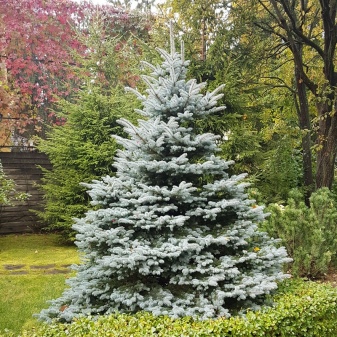

If a representative of the variety grows in a shaded area, then be prepared for the fact that the color of the needles can change and acquire darker shades. The plant is often planted in central Russia, as it tolerates cold well. In addition, spruce is resistant to atmospheric pollution. Due to this Fat Albert is often planted in industrial areas for landscaping purposes... The color of tree cones changes over time. It can range in shades from green to light brown.
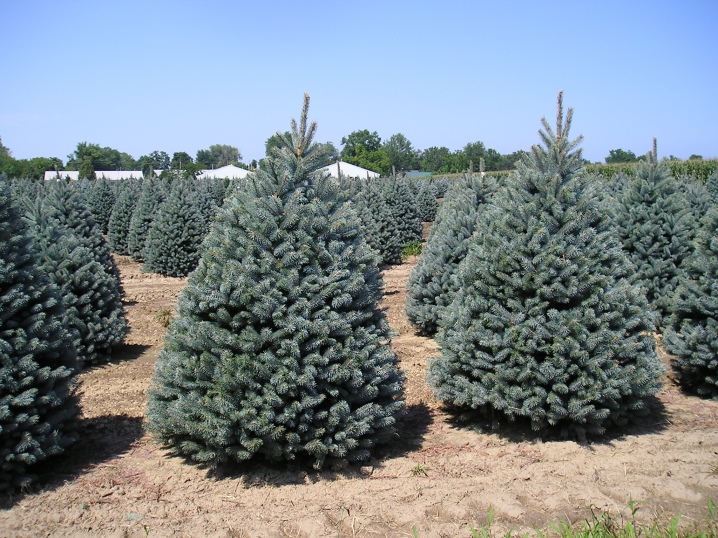
The tree does not need systematic pruning. This procedure is recommended only if "Fat Albert" performs a decorative role.
Bialobok
"Bialobok" is an ornamental variety that manifests its properties most vividly in the spring. At this time, young shoots of a golden yellow color are combined with last year's blue needles, creating an unusual bright composition. The tree grows rather slowly and does not have a constant, delineated shape. At the age of ten, the spruce can reach 2.5 meters in height and 1 meter in width. At the same time, the crown of the variety is very dense and has an irregular shape. Buds of the "Bialobok" type are colored brownish-yellow, have a conical shape and are large in size.
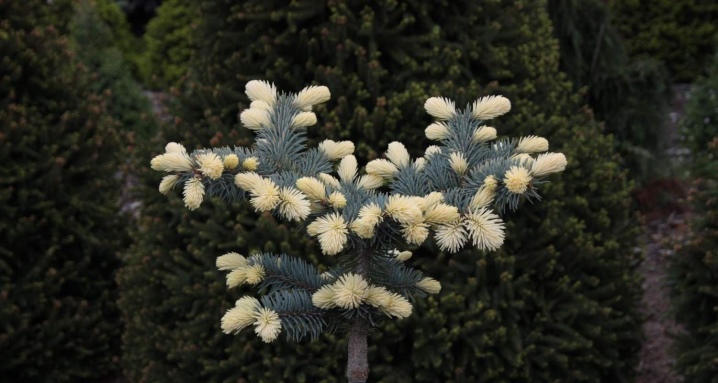
"Bialobok" prefers fertile and moist soil. It is also important that the soil in which the tree grows is well-drained. You should choose loamy and sandy loam soils with a slightly acidic environment. Factors such as soil salinity, overconsolidation and excess moisture have a detrimental effect on the growth and development of a tree. In the process of leaving, it is very important to observe the measure in the process of fertilizing. Otherwise, negative reactions may occur. If "Bialobok" grows in an urban environment (in busy areas or near highways), then you should regularly spray the needles with water to remove contamination.
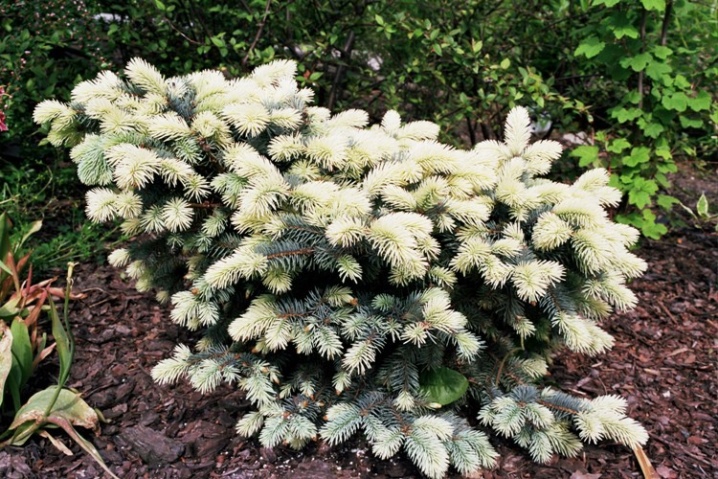
Canadian "Sanders Blue"
This variety belongs to the dwarf category, as it has a very modest size. The shape of the crown is conical. Because of this, the tree is very popular among landscape designers and gardeners. The color of the crown is pale blue. The combination of such external characteristics makes it possible for this spruce to become an adornment of almost any decorative composition on the site. "Sanders Blue" grows rather slowly, adding a maximum of 7 centimeters per year. Thus, by the age of 10 years, the tree reaches a height of 70-80 centimeters. The maximum height ranges from 2 to 3 meters, and the width can be equal to two meters.
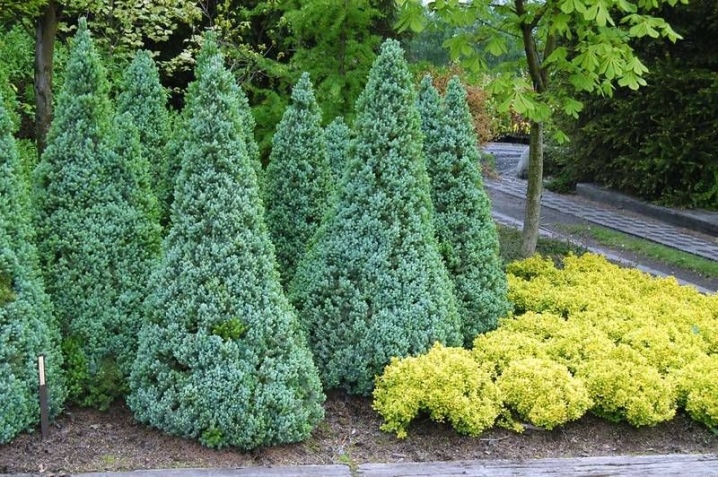
The shoots of the tree fit snugly against the post. Canadian spruce grows and develops most actively in sunny areas, and a small amount of shade is also recommended. The variety is susceptible to moist and moderately rich in mineral and nutrient components. - it is on such soils that it is recommended to plant a tree.In areas where "Sanders Blue" grows, do not allow compaction and stagnation of moisture. This can lead to disastrous consequences for growth and development. This spruce should be planted as far from groundwater as possible. Also, it is imperative to take care of the drainage layer.
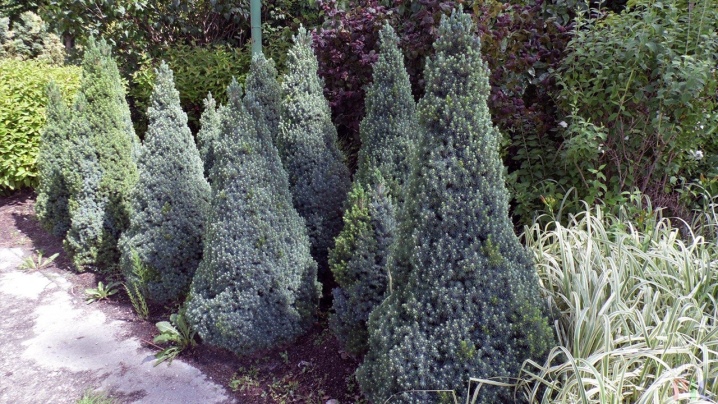
Thus, depending on your personal preferences, you can choose for your site that variety that will fit into the overall design of the site and become its real decoration.
How to choose?
If you plan to plant a blue spruce on your site, then you should carefully choose a specific variety. First of all, evaluate your strength - whether you can pay due attention to caring for the plant. If you are not sure if you have the required amount of time and effort, then it is recommended to give preference to unpretentious varieties. Appearance is another important factor. The spruce should fit into the overall plant composition of your garden. If you are the owner of a small garden area, then choose representatives of dwarf groups. If there is an impressive space, taller specimens can also be planted.

The cost of seedlings should also be considered when choosing a plant. Some species are many times more expensive than their counterparts.
How to grow?
The processes of planting, growing and caring for blue spruce at home are difficult for many gardeners. If you are asking questions about whether it is right to plant seedlings on your site in spring, whether it is possible to plant a blue spruce and grow it from a twig, and also are interested in the recommendations of experts on fertilization, then you should read our advice.
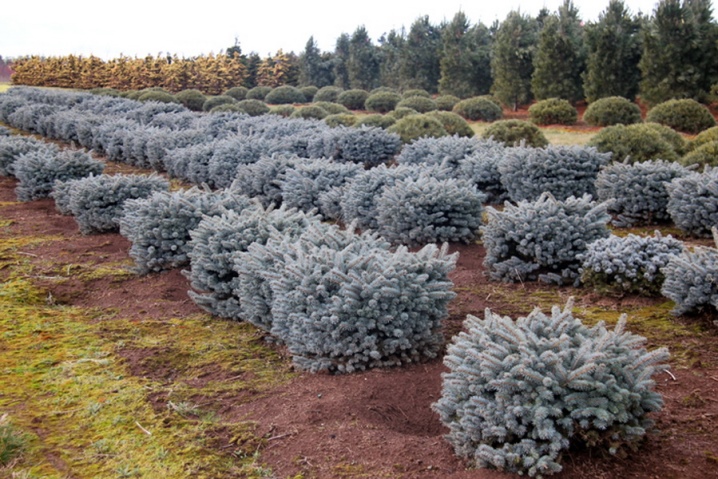
Landing
Planting is a critical step. If you neglect the rules and instructions of specialists and scientists, then the plant will not take root, will not grow and develop. When planting a blue spruce, first of all, you should rely on how many trees you plan to plant. remember, that there should be free space between the seedlings... Trees must be able to grow and develop while increasing in size. If blue spruce seedlings are planted too close to each other, then they will not be able to grow. The minimum distance between trees should be 2 meters.
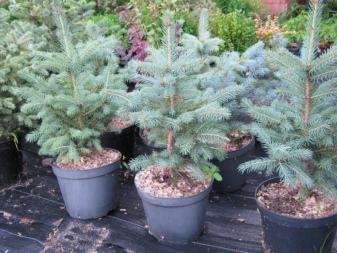
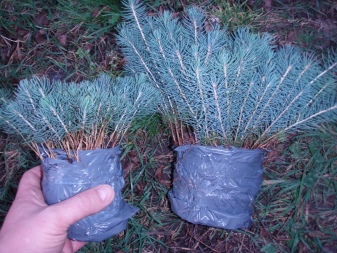
In addition, some other recommendations must be followed. So, for example, for planting seedlings, it is necessary to dig holes. Their depth should not be less than 50 centimeters. It is also not recommended to dig holes deeper than 70 centimeters. In this case, the diameter of the holes depends on the size of the container in which the spruce was growing before. The well should be 50 centimeters larger than the space that the container had.

The bottom of the hole you dug, as well as the cracks between its edges and the earthen lump, must be filled with a pre-prepared mixture. Such a mixture should consist of several mandatory components: soil, peat and sand (in a ratio of 4/2 / 0.5).
Care, watering and feeding
Irrigation is a mandatory care measure for the planted spruce. So, First of all, you should remember that the plant needs a lot of moisture. Usually, water is added 5 to 7 times a day in small portions (if there is an excess amount of water, the root system can rot, since it is close to the surface). It is important to ensure that the ground does not dry out.
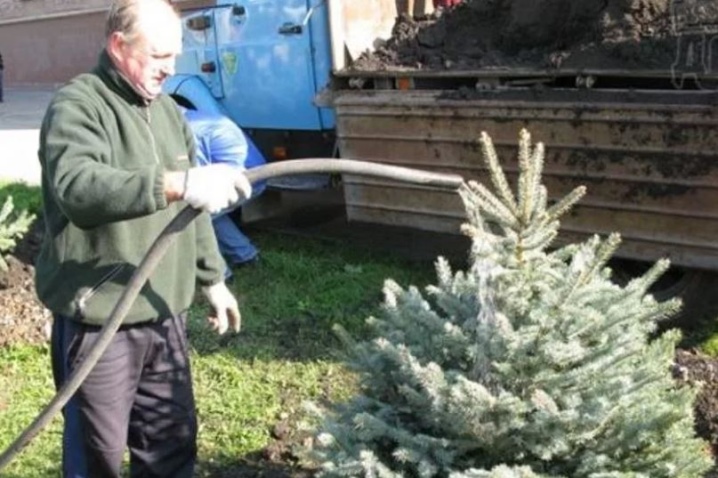
Over time and when the tree reaches the age of 1 year, the amount of watering should be reduced to 2 times a day. At the same time, do not forget to carry out the procedure of loosening and mulching. A mandatory care measure for blue spruce is sprinkling with warm water and spraying. These treatments will help moisturize the plant and remove dust deposits. In general, it is recommended to water the blue spruce by drip method or by irrigation.

In addition to the need to apply liquid, there is also a requirement in relation to fertilizing and fertilization. If we neglect the replenishment of the soil and soil, then the tree will grow very slowly. However, at the same time, one should take into account the fact that blue spruces are very demanding in relation to feeding. So, in no case should fertilizers be applied to the soil in the autumn. This procedure is recommended to be postponed to spring or summer. In addition, manure and nitrogen fertilizers cannot be used as top dressing. Preference should be given to universal mixtures.
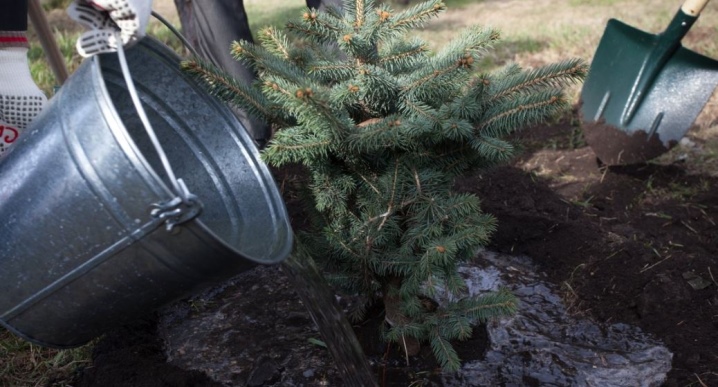
Pruning and shaping the crown
Blue spruce trees do not need to be clipped or pruned regularly. Usually the crown forms and grows on its own. However, the procedure for removing broken branches or branches infected with pests or diseases should not be neglected. It is also recommended to cut off the yellow shoots. Otherwise, not only the appearance of your spruce will deteriorate, but its development will also slow down. If you want to trim the crown for decorative purposes, then these processes should be carried out up to 7 years of age. After that, the formation of the crown should occur naturally.
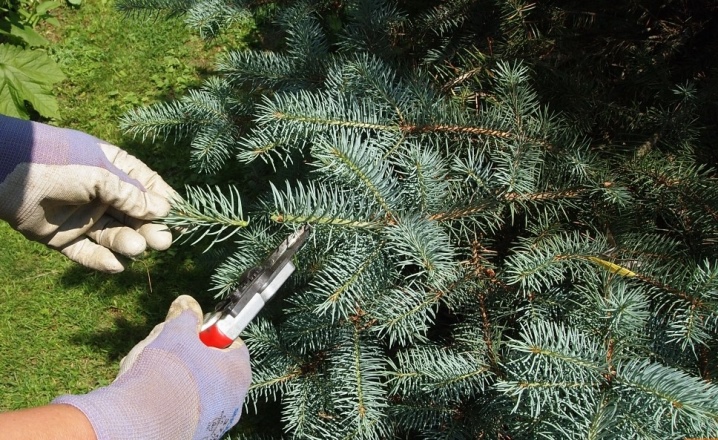
Fight disease
Most often, young, still immature blue spruces suffer from diseases and pests. The most common ailments include:
- schnotte (leads to darkening of the needles);
- rust (fungal spores appear on the tree);
- necrosis (the bark dries up and flakes off);
- tracheomycotic wilting (root rot);
- ulcerative cancer (damage is formed on the trunk).
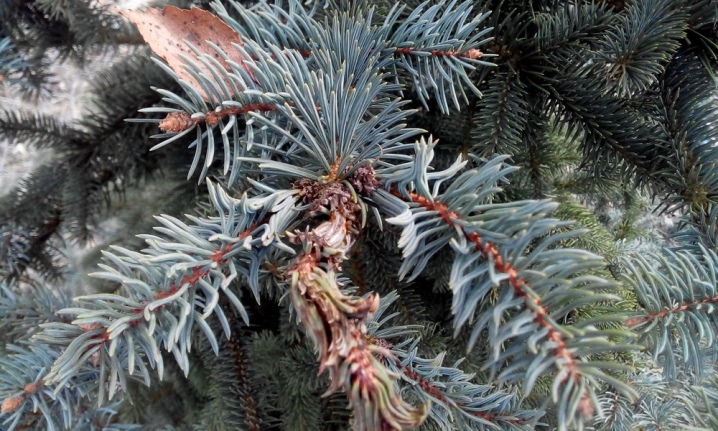
For to rid the spruce of such ailments, it is necessary to carry out compulsory treatment... It will help the spruce turn green, blue or silver again (depending on the original shade). All damaged parts must be removed (cut off, cut down), it is recommended to treat the sawn-off spots with garden varnish, and a solution with a fungicidal preparation must be poured under the tree (on the root system).
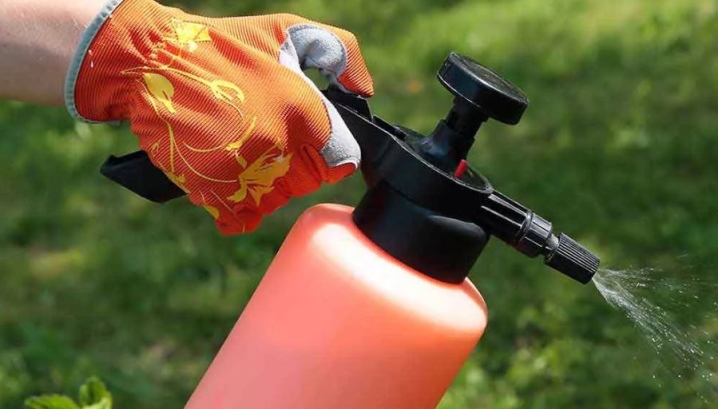
How to propagate?
There are several ways breeding blue spruce:
- cuttings;
- growing seedlings;
- using seeds.

If you decide to breed a blue spruce using the cuttings method, then you should cut off young cuttings from an adult plant (which is at least 5 years old) in spring or summer. For this you should choose branches, the length of which is from 7 to 12 centimeters... Moreover, a small piece of bark should remain at the base. The rooting procedure should be carried out in a greenhouse. You need to plant the cutting in a mixture of sand and peat to a depth of at least 2 centimeters. The plant will take root in 60 days.

To grow seedlings in a gardening store, you need to purchase a young tree about 0.5 meters high. He must be immediately put in a permanent place. If you are planting several spruce trees, keep a distance of at least 2 meters between them. The hole should be about 70 centimeters deep and the bottom should be covered with sand and gravel. In order to grow a tree with seeds, you need to collect seeds from ripe cones, and then rinse them with water and a weak solution of manganese. Before planting, it is recommended to soak the seeds in a fungicidal solution for 12 hours, and then dry them. After that, the seeds are sown in the ground and mulched. Blue spruce is most often propagated by this method.
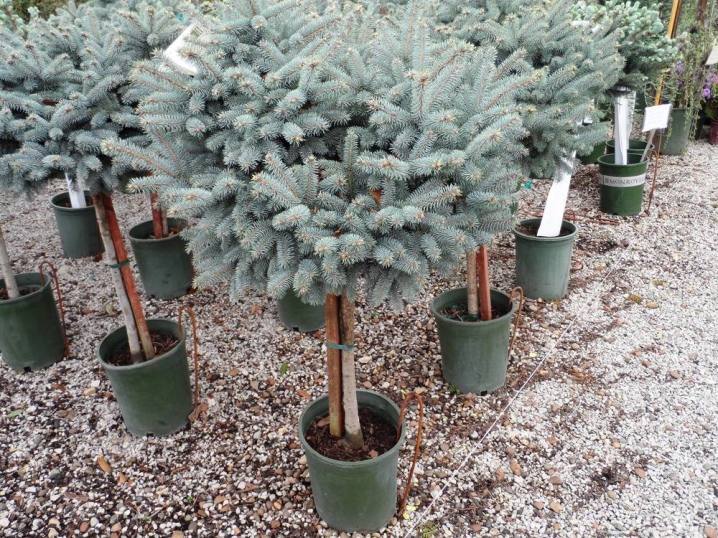
Examples in landscape design
Blue spruce is very often used in landscaping. It is planted both independently and is used to decorate compositions. For private plots, dwarf varieties are most preferred, as they look pretty neat. At the same time, if you want to give your site status and nobility, then it is recommended to use large blue spruces.
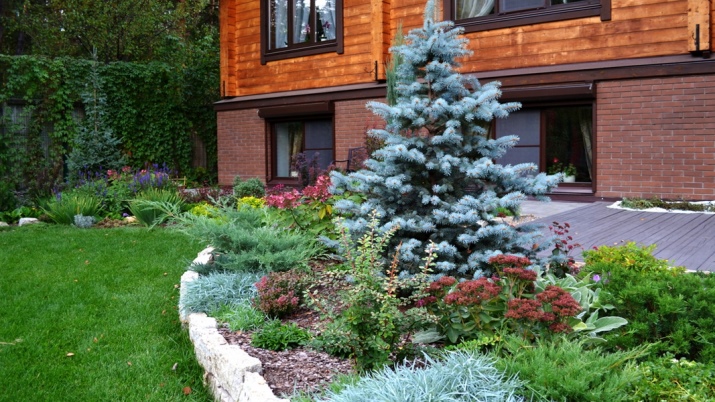
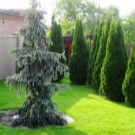
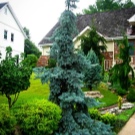
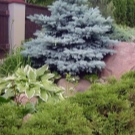
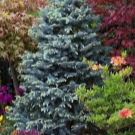
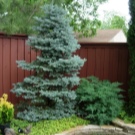
Here are some examples of how you can add flavor to the design of the site with the help of spruce.
- If you live in a country house, then with the help of a dwarf blue spruce, you can decorate its perimeter or plant a plant near the window.
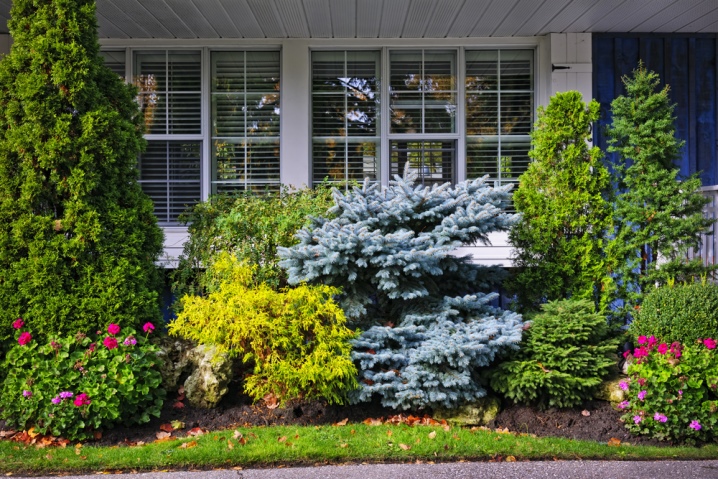
- If you have a pond in your yard, then a blue spruce will be a great addition to such a natural landscape.
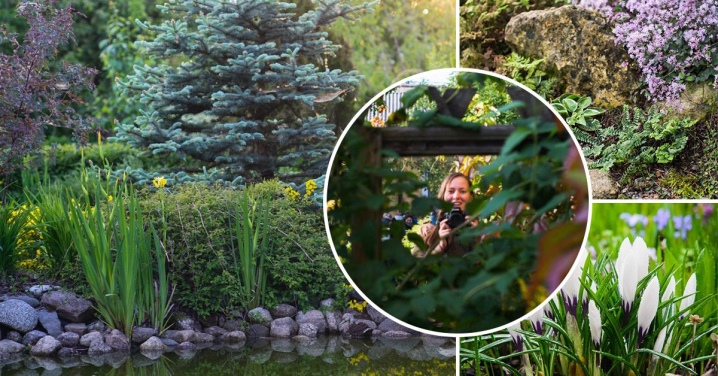
- Blue spruce trees planted along the path will look great.
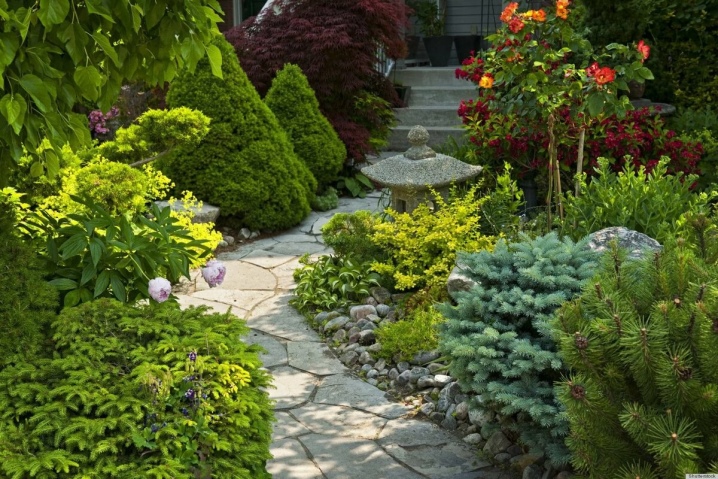
For information on how to plant a blue spruce correctly, see the next video.



































































The comment was sent successfully.